

Compact Muon Solenoid
LHC, CERN
| CMS-SUS-17-006 ; CERN-EP-2017-322 | ||
| Search for physics beyond the standard model in events with high-momentum Higgs bosons and missing transverse momentum in proton-proton collisions at 13 TeV | ||
| CMS Collaboration | ||
| 22 December 2017 | ||
| Phys. Rev. Lett. 120 (2018) 241801 | ||
| Abstract: A search for physics beyond the standard model in events with one or more high-momentum Higgs bosons, H, decaying to pairs of b quarks in association with missing transverse momentum is presented. The data, corresponding to an integrated luminosity of 35.9 fb−1, were collected with the CMS detector at the LHC in proton-proton collisions at the center-of-mass energy √s= 13 TeV. The analysis utilizes a new b quark tagging technique based on jet substructure to identify jets from H→bˉb. Events are categorized by the multiplicity of H-tagged jets, jet mass, and the missing transverse momentum. No significant deviation from standard model expectations is observed. In the context of supersymmetry (SUSY), limits on the cross sections of pair-produced gluinos are set, assuming that gluinos decay to quark pairs, H (or Z), and the lightest SUSY particle, LSP, through an intermediate next-to-lightest SUSY particle, NLSP. With large mass splitting between the NLSP and LSP, and 100% NLSP branching fraction to H, the lower limit on the gluino mass is found to be 2010 GeV. | ||
| Links: e-print arXiv:1712.08501 [hep-ex] (PDF) ; CDS record ; inSPIRE record ; CADI line (restricted) ; | ||
| Figures & Tables | Summary | Additional Figures & Tables | References | CMS Publications |
|---|
| Additional technical material for CMS speakers can be found here. |
| Figures | |

png pdf |
Figure 1:
Diagram for production of Higgs bosons via gluino pair production. We also consider channels in which a Z boson is substituted for H in one of the gluino decays. |
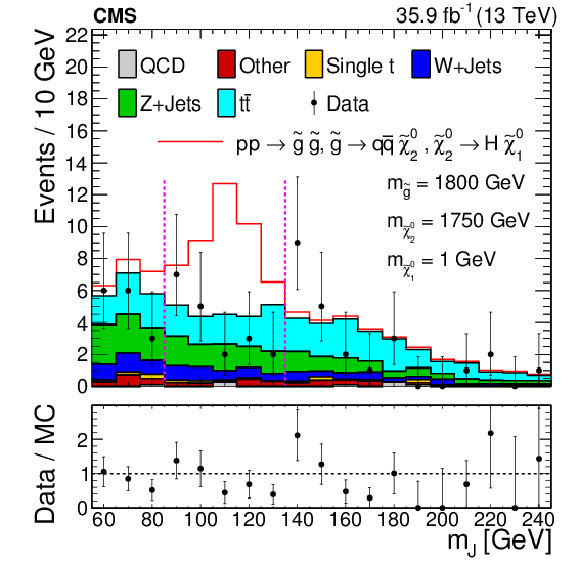
png pdf |
Figure 2:
Observed and expected distributions of the leading-pT jet mass for selected 1H and 2H events with pTmiss> 300 GeV. The subleading jet is required to have mJ within the signal window denoted by vertical dashed magenta lines. The shape and composition of SM contributions are modeled with simulations while the overall normalization is scaled to the prediction in the signal window. A representative signal is shown stacked on top of the backgrounds. The bottom panel shows the ratio of the observed to SM-expected yields. |

png pdf root |
Figure 3:
Observed and expected cross section upper bounds at 95 CL for the T5HH and T5HZ models. The solid and dashed black lines show the SMS gluino-gluino production cross section with its uncertainty. The solid red (blue) line shows the observed limit for the T5HH (T5HZ) model; for each the like-colored dashed line and shaded band show the expected limit and the range associated with the experimental uncertainties. |
| Tables | |

png pdf |
Table 1:
Correction factors, predicted SM background yields, and observed yields, for the signal regions ANH. The uncertainties in the predictions include both statistical and systematic contributions. |
| Summary |
|
In summary, this Letter has presented a search for production of energetic Higgs bosons in conjunction with large missing transverse momentum in proton-proton collisions. Higgs bosons with transverse momentum in the range 300 GeV to about 2 TeV are reconstructed as wide-cone jets with substructure indicative of the decay of the Higgs boson to a pair of b quarks. Background from standard model processes is estimated from data control regions. The observed event yields are found to be statistically compatible with these backgrounds. The results are broadly applicable to models leading to signatures with energetic Higgs bosons and missing momentum. Here they are interpreted in the context of a simplified model of supersymmetry in which gluinos are pair produced and subsequently decay into several quarks, a Higgs or Z boson, and the lightest supersymmetric particle, a neutralino ˜χ01. Gluinos with masses below 2010 (1825) GeV are excluded under the assumption of a large mass splitting between the next-to-lightest and lightest supersymmetric particle and that the branching fraction of ˜χ02→H˜χ01 is 100% (50%). These are the first limits for pair production of gluinos measured in these decay channels. |
| Additional Figures | |

png pdf |
Additional Figure 1:
Signal diagram for the T5ZH model, a topology consisting of boosted Higgs and Z bosons via gluino strong production. We consider a 50% branching fraction to Higgs bosons and a 50% branching fraction to Z bosons. |

png pdf |
Additional Figure 2:
Diagram depicting each of the 6 analysis regions. Those in red signify the high-purity signal regions. Those in blue signify the low-purity sideband regions, which serve to determine the background yields in the high-purity signal regions. The y-axis represents the bb-tagging requirements for the leading and sub-leading jets. The x-axis shows the mass of the leading or sub-leading jet which lies farthest from the center of the Higgs mass window (85,135 GeV). |

png pdf |
Additional Figure 3:
The background composition in each of the six analysis regions, integrated over pTmiss. The left column shows the three regions with jets in the mass window (85, 135 GeV) (i.e. Regions A1, A2, C). The right column shows the three regions in the mass sideband (50, 85 GeV) and (135, 250 GeV) (i.e. Regions B1, B2, D). |
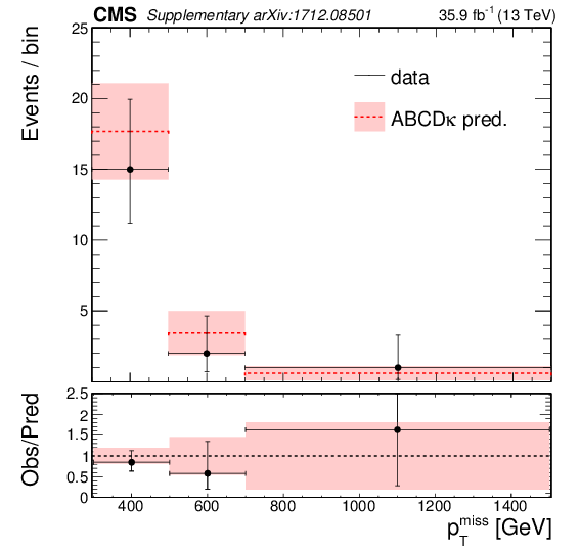
png pdf |
Additional Figure 4:
Distribution of pTmiss in the single-Higgs tagged signal region (A1) comparing the observed yields and background prediction from data. |
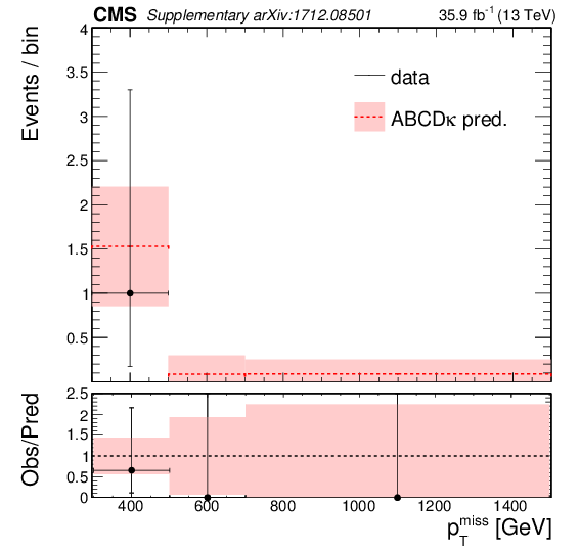
png pdf |
Additional Figure 5:
Distribution of pTmiss in the double-Higgs tagged signal region (A2) comparing the observed yields and background prediction from data. |
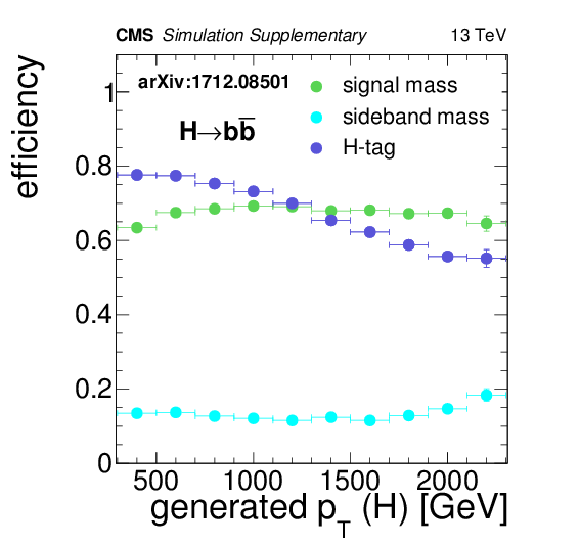
png pdf root |
Additional Figure 6:
Efficiencies for an AK8 jet originating from H→bˉb decay, relative to baseline selection. The 'signal mass' curve represents the probability that the jet will fall within the mass region (85, 135 GeV). The 'sideband mass' curve represents the probability that the jet will fall within the mass region (50, 85 GeV) or (135, 250 GeV). The 'H-tag' curve represents the probability for the jet to have a double-b discriminator value greater than 0.3, for jets within the mass region (50, 250 GeV). |

png pdf root |
Additional Figure 7:
Efficiencies for an AK8 jet originating from H→WW→4q decay, relative to baseline selection. The 'signal mass' curve represents the probability that the jet will fall within the mass region (85, 135 GeV). The 'sideband mass' curve represents the probability that the jet will fall within the mass region (50, 85 GeV) or (135, 250 GeV). The 'H-tag' curve represents the probability for jet to have a double-b discriminator value greater than 0.3, for jets within the mass region (50, 250 GeV). |
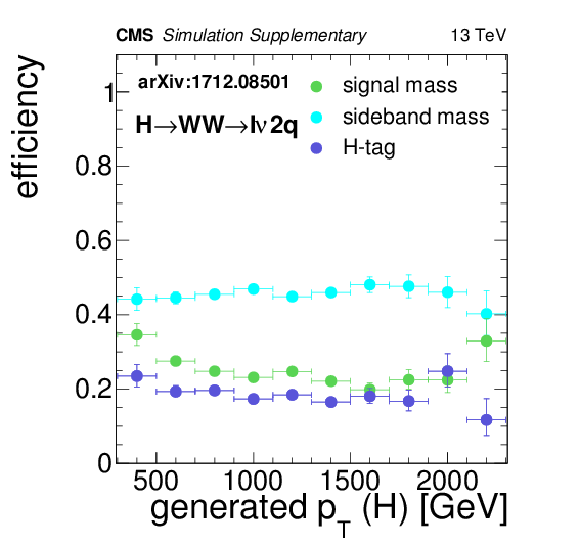
png pdf root |
Additional Figure 8:
Efficiencies for an AK8 jet originating from H→WW→ℓν2q decay, relative to baseline selection. The 'signal mass' curve represents the probability that the jet will fall within the mass region (85, 135 GeV). The 'sideband mass' curve represents the probability that the jet will fall within the mass region (50, 85 GeV) or (135, 250 GeV). The 'H-tag' curve represents the probability for jet to have a double-b discriminator value greater than 0.3, for jets within the mass region (50, 250 GeV). |
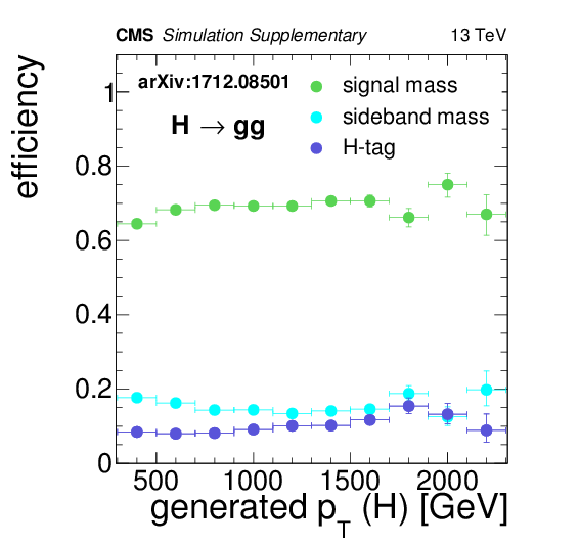
png pdf root |
Additional Figure 9:
Efficiencies for an AK8 jet originating from H→gg decay, relative to baseline selection. The 'signal mass' curve represents the probability that the jet will fall within the mass region (85, 135 GeV). The 'sideband mass' curve represents the probability that the jet will fall within the mass region (50, 85 GeV) or (135, 250 GeV). The 'H-tag' curve represents the probability for jet to have a double-b discriminator value greater than 0.3, for jets within the mass region (50, 250 GeV). |
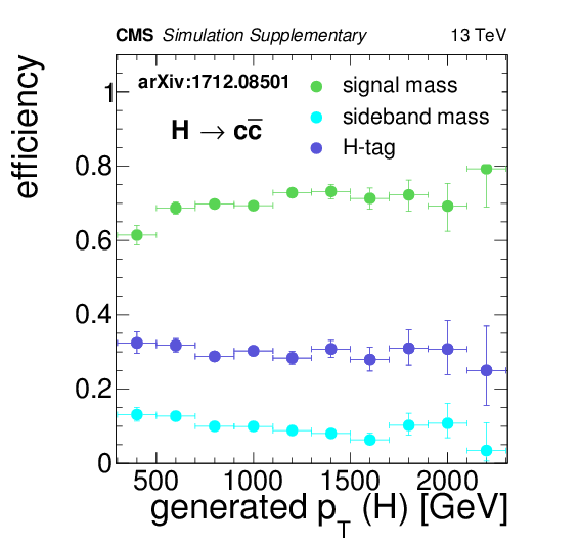
png pdf root |
Additional Figure 10:
Efficiencies for an AK8 jet originating from H→cˉc decay, relative to baseline selection. The 'signal mass' curve represents the probability that the jet will fall within the mass region (85, 135 GeV). The 'sideband mass' curve represents the probability that the jet will fall within the mass region (50, 85 GeV) or (135, 250 GeV). The 'H-tag' curve represents the probability for jet to have a double-b discriminator value greater than 0.3, for jets within the mass region (50, 250 GeV). |

png pdf root |
Additional Figure 11:
Efficiencies for an AK8 jet originating from Z→bˉb decay, relative to baseline selection. The 'signal mass' curve represents the probability that the jet will fall within the mass region (85, 135 GeV). The 'sideband mass' curve represents the probability that the jet will fall within the mass region (50, 85 GeV) or (135, 250 GeV). The 'H-tag' curve represents the probability for jet to have a double-b discriminator value greater than 0.3, for jets within the mass region (50, 250 GeV). |

png pdf root |
Additional Figure 12:
Efficiencies for an AK8 jet originating from Z→udsc pair decay, relative to baseline selection. The 'signal mass' curve represents the probability that the jet will fall within the mass region (85, 135 GeV). The 'sideband mass' curve represents the probability that the jet will fall within the mass region (50, 85 GeV) or (135, 250 GeV). The 'H-tag' curve represents the probability for jet to have a double-b discriminator value greater than 0.3, for jets within the mass region (50, 250 GeV). |
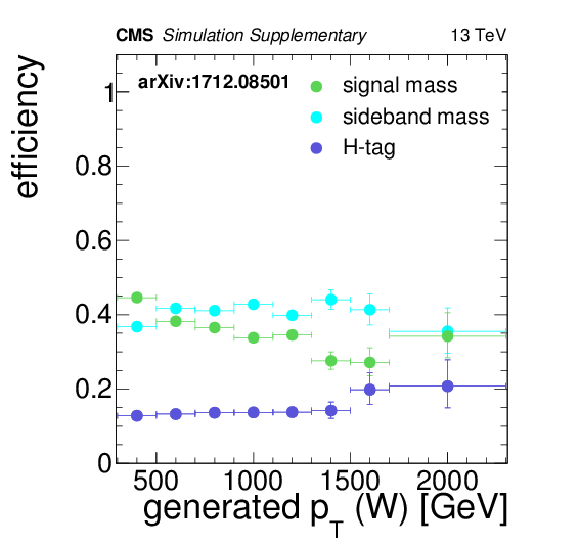
png pdf root |
Additional Figure 13:
Efficiencies for an AK8 jet originating from W decay (all modes), relative to events with no leptons or isolated tracks. The 'signal mass' curve represents the probability that the jet will fall within the mass region (85, 135 GeV). The 'sideband mass' curve represents the probability that the jet will fall within the mass region (50, 85 GeV) or (135, 250 GeV). The 'H-tag' curve represents the probability for jet to have a double-b discriminator value greater than 0.3, for jets within the mass region (50, 250 GeV). |
| Additional Tables | |

png pdf |
Additional Table 1:
Results table, including the data yields in the 6 analysis ABCD regions. The predicted background for each signal region can be calculated as B*(C/D)*kappa. This prediction assumes no contribution from signal events in the control regions, B, C, and D. If signal is expected from a given model in the B, C, D regions, an adjusted SM background prediction for the signal region can be computed by subtracting the expected signal contribution to regions B, C, and D from the observed yields and recomputing B*(D/C)*kappa with these signal-contamination corrected yields in B, C, and D. |

png pdf |
Additional Table 2:
Cut flow table showing the total yields at 35.9 fb−1 for both the T5HH and T5ZH models with gluino masses of 1300 and 2200 GeV. |

png pdf |
Additional Table 3:
Signal event efficiencies for the T5HH model with a 2200 GeV gluino mass. Choosing a gluino mass of 1800 GeV decreases the efficiencies by a relative 5%. |
| References | ||||
| 1 | L. Evans and P. Bryant | LHC machine | JINST 3 (2008) S08001 | |
| 2 | ATLAS Collaboration | Observation of a new particle in the search for the Standard Model Higgs boson with the ATLAS detector at the LHC | PLB 716 (2012) 1 | 1207.7214 |
| 3 | CMS Collaboration | Observation of a new boson at a mass of 125 GeV with the CMS experiment at the LHC | PLB 716 (2012) 30 | CMS-HIG-12-028 1207.7235 |
| 4 | ATLAS and CMS Collaborations | Combined measurement of the Higgs boson mass in pp collisions at √s= 7 and 8 TeV with the ATLAS and CMS experiments | PRL 114 (2015) 191803 | 1503.07589 |
| 5 | Particle Data Group, C. Patrignani et al. | Review of Particle Physics | CPC 40 (2016) 100001, .See section 26, Dark Matter | |
| 6 | F. Zwicky | Die rotverschiebung von extragalaktischen nebeln | Helv. Phys. Acta 6 (1933)110 | |
| 7 | V. C. Rubin and W. K. Ford Jr | Rotation of the Andromeda nebula from a spectroscopic survey of emission regions | Astrophys. J. 159 (1970) 379 | |
| 8 | B. A. Dobrescu and C. Frugiuele | Hidden GeV-scale interactions of quarks | PRL 113 (2014) 061801 | 1404.3947 |
| 9 | B. A. Dobrescu | Leptophobic boson signals with leptons, jets and missing energy | 1506.04435 | |
| 10 | R. K. Barman, B. Bhattacherjee, A. Chakraborty, and A. Choudhury | Study of MSSM heavy Higgs bosons decaying into charginos and neutralinos | PRD 94 (2016) 075013 | 1607.00676 |
| 11 | S. Gori, P. Schwaller, and C. E. M. Wagner | Search for Higgs bosons in supersymmetric cascade decays and neutralino dark matter | PRD 83 (2011) 115022 | 1103.4138 |
| 12 | CMS Collaboration | Identification of heavy-flavour jets with the CMS detector in pp collisions at 13 TeV | Submitted to \it JINST | CMS-BTV-16-002 1712.07158 |
| 13 | CMS Collaboration | Search for top squark and higgsino production using diphoton Higgs boson decays | PRL 112 (2014) 161802 | CMS-SUS-13-014 1312.3310 |
| 14 | CMS Collaboration | Searches for electroweak neutralino and chargino production in channels with Higgs, Z, and W bosons in pp collisions at 8 TeV | PRD 90 (2014) 092007 | CMS-SUS-14-002 1409.3168 |
| 15 | ATLAS Collaboration | Search for supersymmetry in events with photons, bottom quarks, and missing transverse momentum in proton-proton collisions at a centre-of-mass energy of 7 TeV with the ATLAS detector | PLB 719 (2013) 261 | 1211.1167 |
| 16 | P. Ramond | Dual theory for free fermions | PRD 3 (1971) 2415 | |
| 17 | Y. A. Gol'fand and E. P. Likhtman | Extension of the algebra of Poincar\'e group generators and violation of P invariance | JEPTL 13 (1971)323 | |
| 18 | A. Neveu and J. H. Schwarz | Factorizable dual model of pions | NPB 31 (1971) 86 | |
| 19 | D. V. Volkov and V. P. Akulov | Possible universal neutrino interaction | JEPTL 16 (1972)438 | |
| 20 | J. Wess and B. Zumino | A lagrangian model invariant under supergauge transformations | PLB 49 (1974) 52 | |
| 21 | J. Wess and B. Zumino | Supergauge transformations in four dimensions | NPB 70 (1974) 39 | |
| 22 | P. Fayet | Supergauge invariant extension of the Higgs mechanism and a model for the electron and its neutrino | NPB 90 (1975) 104 | |
| 23 | H. P. Nilles | Supersymmetry, supergravity and particle physics | Phys. Rep. 110 (1984) 1 | |
| 24 | R. Barbieri and G. F. Giudice | Upper bounds on supersymmetric particle masses | NPB 306 (1988) 63 | |
| 25 | S. Dimopoulos and G. F. Giudice | Naturalness constraints in supersymmetric theories with nonuniversal soft terms | PLB 357 (1995) 573 | hep-ph/9507282 |
| 26 | R. Barbieri and D. Pappadopulo | S-particles at their naturalness limits | JHEP 10 (2009) 061 | 0906.4546 |
| 27 | M. Papucci, J. T. Ruderman, and A. Weiler | Natural SUSY endures | JHEP 09 (2012) 035 | 1110.6926 |
| 28 | J. Alwall, P. C. Schuster, and N. Toro | Simplified models for a first characterization of new physics at the LHC | PRD 79 (2009) 075020 | 0810.3921 |
| 29 | J. Alwall, M.-P. Le, M. Lisanti, and J. G. Wacker | Model-independent jets plus missing energy searches | PRD 79 (2009) 015005 | 0809.3264 |
| 30 | D. Alves et al. | Simplified models for LHC new physics searches | JPG 39 (2012) 105005 | 1105.2838 |
| 31 | CMS Collaboration | The CMS experiment at the CERN LHC | JINST 3 (2008) S08004 | CMS-00-001 |
| 32 | CMS Collaboration | Particle-flow reconstruction and global event description with the CMS detector | JINST 12 (2017) P10003 | CMS-PRF-14-001 1706.04965 |
| 33 | M. Cacciari, G. P. Salam, and G. Soyez | The anti-kt jet clustering algorithm | JHEP 04 (2008) 063 | 0802.1189 |
| 34 | M. Cacciari, G. P. Salam, and G. Soyez | FastJet user manual | EPJC 72 (2012) 1896 | 1111.6097 |
| 35 | CMS Collaboration | Jet energy scale and resolution in the CMS experiment in pp collisions at 8 TeV | JINST 12 (2017) P02014 | CMS-JME-13-004 1607.03663 |
| 36 | M. Cacciari and G. P. Salam | Pileup subtraction using jet areas | PLB 659 (2008) 119 | 0707.1378 |
| 37 | S. D. Ellis, C. K. Vermilion, and J. R. Walsh | Recombination algorithms and jet substructure: Pruning as a tool for heavy particle searches | PRD 81 (2010) 094023 | 0912.0033 |
| 38 | CMS Collaboration | The CMS trigger system | JINST 12 (2017) P01020 | CMS-TRG-12-001 1609.02366 |
| 39 | UA1 Collaboration | Experimental observation of isolated large transverse energy electrons with associated missing energy at √s= 540 ~GeV | PLB 122 (1983) 103 | |
| 40 | J. Alwall et al. | The automated computation of tree-level and next-to-leading order differential cross sections, and their matching to parton shower simulations | JHEP 07 (2014) 079 | 1405.0301 |
| 41 | NNPDF Collaboration | Parton distributions for the LHC Run II | JHEP 04 (2015) 040 | 1410.8849 |
| 42 | CMS Collaboration | Search for supersymmetry in multijet events with missing transverse momentum in proton-proton collisions at 13 TeV | PRD 96 (2017) 032003 | CMS-SUS-16-033 1704.07781 |
| 43 | GEANT4 Collaboration | GEANT4---a simulation toolkit | NIMA 506 (2003) 250 | |
| 44 | C. Borschensky et al. | Squark and gluino production cross sections in pp collisions at √s= 13, 14, 33 and 100 TeV | EPJC 74 (2014) 3174 | 1407.5066 |
| 45 | S. Catani, D. de Florian, M. Grazzini, and P. Nason | Soft gluon resummation for Higgs boson production at hadron colliders | JHEP 07 (2003) 028 | hep-ph/0306211 |
| 46 | M. Cacciari et al. | The tˉt cross-section at 1.8 TeV and 1.96 TeV: a study of the systematics due to parton densities and scale dependence | JHEP 04 (2004) 068 | hep-ph/0303085 |
| 47 | G. Cowan, K. Cranmer, E. Gross, and O. Vitells | Asymptotic formulae for likelihood-based tests of new physics | EPJC 71 (2011) 1554 | 1007.1727 |
| 48 | A. L. Read | Presentation of search results: the CLs technique | in Durham IPPP Workshop: Advanced Statistical Techniques in Particle Physics, p. 2693 Durham, UK, March, 2002 [JPG 28 (2002) 2693] | |
| 49 | T. Junk | Confidence level computation for combining searches with small statistics | NIMA 434 (1999) 435 | hep-ex/9902006 |
| 50 | ATLAS and CMS Collaborations, LHC Higgs Combination Group | Procedure for the LHC Higgs boson search combination in Summer 2011 | CMS-NOTE-2011-005 | |

|
Compact Muon Solenoid LHC, CERN |

|

|

|

|

|

|